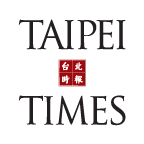Taiwan’s pure-play wafer foundry industry this year is expected to benefit from strong demand for advanced processes, with sales forecast to grow 15 percent from last year, Digitimes Research wrote in a report last week.
Taiwan’s pure-play wafer foundry firms are expected to post a record-high revenue of more than US$90 billion this year, compared with US$78.7 billion last year, the report said.
Due to solid demand for advanced 3, 4 and 5-nanometer processes at a time of growing shipments of smartphones, PCs and servers, sales in the foundry industry are expected to stage a rebound from last year, Digitimes Research analyst Eric Chen (陳澤嘉) wrote in the report
 Researchers inspect a silicon wafer at a National Tsing Hua University laboratory in Hsinchu City on Sept. 11, 2022.
Researchers inspect a silicon wafer at a National Tsing Hua University laboratory in Hsinchu City on Sept. 11, 2022.
Photo: CNA
However, sales for the first quarter of this year are expected to fall 6.5 percent from a quarter earlier due to traditional slow season effects, Chen said.
Revenue generated by the local pure-play wafer foundry industry last year was estimated to reach US$78.7 billion, down 12 percent from a year earlier amid inventory adjustments, the report said.
However, the anticipated year-on-year decline is smaller than the previous forecast of a 13 percent fall, as shipments of the 3, 4 and 5-nanometer processes for 5G smartphone and high-performance computing device production in the second half of this year beat earlier expectations, it said.
Last year, demand for chips made using mature processes remained weak in the second half of the year, with the industry’s average capacity utilization ratio expected to hit only 70 percent, Chen said.
Taiwan Semiconductor Manufacturing Co (TSMC, 台積電) currently has a more than 50 percent market share in the pure-play foundry industry.
TSMC chief executive officer C.C. Wei (魏哲家) told an investors’ conference in October last year that solid demand for the company’s 3-nanometer process was offsetting the impact of inventory adjustments in the global semiconductor sector last year.
Growing demand for the 3-nanometer process would continue into this year, meaning TSMC is likely to see healthy growth momentum, Wei said.

 www.taipeitimes.com
www.taipeitimes.com
Taiwan’s pure-play wafer foundry firms are expected to post a record-high revenue of more than US$90 billion this year, compared with US$78.7 billion last year, the report said.
Due to solid demand for advanced 3, 4 and 5-nanometer processes at a time of growing shipments of smartphones, PCs and servers, sales in the foundry industry are expected to stage a rebound from last year, Digitimes Research analyst Eric Chen (陳澤嘉) wrote in the report

Photo: CNA
However, sales for the first quarter of this year are expected to fall 6.5 percent from a quarter earlier due to traditional slow season effects, Chen said.
Revenue generated by the local pure-play wafer foundry industry last year was estimated to reach US$78.7 billion, down 12 percent from a year earlier amid inventory adjustments, the report said.
However, the anticipated year-on-year decline is smaller than the previous forecast of a 13 percent fall, as shipments of the 3, 4 and 5-nanometer processes for 5G smartphone and high-performance computing device production in the second half of this year beat earlier expectations, it said.
Last year, demand for chips made using mature processes remained weak in the second half of the year, with the industry’s average capacity utilization ratio expected to hit only 70 percent, Chen said.
Taiwan Semiconductor Manufacturing Co (TSMC, 台積電) currently has a more than 50 percent market share in the pure-play foundry industry.
TSMC chief executive officer C.C. Wei (魏哲家) told an investors’ conference in October last year that solid demand for the company’s 3-nanometer process was offsetting the impact of inventory adjustments in the global semiconductor sector last year.
Growing demand for the 3-nanometer process would continue into this year, meaning TSMC is likely to see healthy growth momentum, Wei said.

Strong new year demand forecast for pure-play fabs - Taipei Times
Bringing Taiwan to the World and the World to Taiwan
